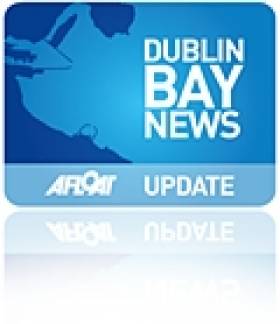Displaying items by tag: Dun Laoghaire
Public Meeting On Dun Laoghaire Cruise Liner Plans Tomorrow
#CruiseBerth - Richard Boyd Barrett TD and local author Alison Hackett are among the speakers lined up for a public meeting on Dun Laoghaire Harbour's controversial cruise liner berth plans tomorrow evening (Monday 7 September).
Activist group Save Our Seafront is hosting 'An Alternative Vision for Dun Laoghaire Harbour' at 8pm in The Kingston Hotel to discuss the Dun Laoghaire Harbour Company's proposals for a next-generation cruise liner terminal that Boyd Barrett and Hackett agree would "destroy" the unique aspect of the harbour.
Other speakers on the night will include An Taisce's Fergal McLoughlin and Liam Shanahan of the National Yacht Club, whose joint submission to An Bord Pleanála over the cruise berth plans (as a part of the Dun Laoghaire Combined Clubs) was recently published online.
Dun Laoghaire's Water Wag Dinghy Fleet Celebrates Record Turn Out
The Water Wag fleet had one overriding objective for 2015, to achieve a race turnout of more than 25 Water Wags in a Wednesday evening club race writes Vincent Delany. It must be at least 20 years ago that the 25 boat fleet was first achieved by Class Captain Simon Nolan for his Captain’s Prize race.
The Captain’s Prize race is generally held at the end of August when families have returned from their annual holidays, and this year David McFarlane called for his race on 2nd. September. Would the Wags be able to beat their own record? It had been equalled on many occasions. In the 1890s the record stood at about 12 boats, this was increased to about 14 in the 1900s. 17 boats raced in the 1940s, at which time the ballot race was the most popular race. It seems that everybody wanted to get their hands on the fastest boats, which were Alfa and Coquette, to find out what was so special about them. Such numbers were not achieved again until the Centenary Regatta in 1987, when 24 boats were afloat and racing.
The 2nd. September turned out to be quite a breezy evening, from the north west. Waves were getting into the harbour along the east pier where wind and tide were running in opposite directions. There were two general recalls before the huge fleet started. Quickly Swift, Mollie, Gavotte, and Tortoise pulled out a lead. Behind them there was a busy bunch of boats, and when on the first offshore leg a strong gust blew through the harbour, causing the Water Wags to cause quite a chop. The lighter boats were able to plane while others struggled to manage their spinnakers. The battle between Swift and Mollie was a great battle between two strong husband/wife teams. It appears that there were no collisions during the evening, and at the end of four laps of the harbour, the finishing order was:
At the finish the places were:
1st. Mollie, Cathy MacAleavey & Con Murphy. Winners division 1A.
2nd. Swift, Guy & Jackie Kilroy.
3rd. Tortoise, William Prentice & Corentin Sauniere.
4th. Gavotte, Frank Guy & Owen McNally.
5th. Little Tern, Tim & Marcus Pearson (despite breaking their spinnaker pole.)
6th. Moosmie, David McFarlane & Cora Bourke.
7th. Eva, Orla Fitzgerald & Dermot O’Flynn. Winners div.1B.
8th. Barbara, Ian & Judith Malcolm.
9th. Polly, Ben Mitchell & Henry Rooke Winner division 2.
10th. Sprite, Tim Carpenter & Jeff Davys. Oldest Water Wag afloat at 111 years.
11th. Freddie, David Corcoran.
12th. Coquette, Seymour Cresswell & Mary Aspied.
13th. Good Hope, Hal Sisk & Sue Reardon.
14th. Ethna, Bill Nolan & Niamh Hooper.
15th. Skee, Jonathan O’Rourke & Carol Cronin.
16th. Nandor, Brian McBride & Ian Moore.
17th. Sara, Paul Smith & Isobel Kennedy.
18th. Chloe, Kate O’Leary & James O’Connor.
19th. Swallow, David & Ann Clarke.
20th. Pansy, Vincent Delany & Noelle Breen.
21st. Maureen, Kilian Skay & Stephen McDermott.
22nd. Eros, Gavin Johnson & Gail Varian.
DNF. Marie Louise, Philip Mahony & Sylvian Vonderweidt.
DNF Alfa, Michael & Jenny Donohoe.
DNF Penelope, Fergus Cullen and Alice Walsh.
DNF Scallywag, Dan O’Connor & David Williams.
DNF Vela, Brian Bond & Mary Ryder.
DNF Marcia, Ben McCormick.
Yes, The Water Wags are to be congratulated on having 28 hand made one-design wooden boats on their start line on a evening race where the wind was gusting to 25knots. Watch out next Wednesday, we might do it again!
#dlregatta – As well as winning the 'Volvo Boat of the week award' with George Sisk's offshore performance in Wow, the Royal Irish Yacht Club topped the leaderboard of Dun Laoghaire's waterfront clubs with eight wins across IRC and one designs at yesterday's Volvo Dun Laoghaire Regatta. The club took wins in IRC One, IRC Four, J109, White Sails Two, Dragon, Beneteau 21 and Mermaid. Significantly, the RIYC won two of three national Championships being sailed as part of the extensive 29 class regatta programme. ICRA divison one champion, John Maybury's Joker II came from behind yesterday afternoon to win the J109 Irish title after a battle with Howth Yacht Storm in an 11-boat fleet. Séamus Storan's Capilano of the RIYC overhauled a Scottish entry to win in a 13-boat Beneteau 21 fleet.
As well as boat of the week, the Royal Irish also won VDLR's 'Best Overall IRC Yacht' with an impressive performance by club–quarter tonner Cri–Cri skippered by Paul Colton in IRC four. Paul O'Higgin's Rockabill V took the final advantage yesterday to take IRC one from overnight leader Tony Fox's A35 Gringo of the National Yacht Club who suffered from a premature start.
Neighbours at the Royal St. George YC were not far behind in the winning stakes. The George won in seven classes of the one design divisions from Beneteau 31.7 keelboats to GP14 dinghies. The National Yacht Club had five class victories; White Sails one, Flying Fifteen, SB20, Shipman and Moth.
The event that is organised by all four Dun Laoghaire waterfront clubs is being hailed a huge success both afloat and ashore. Although 180 visiting boats, made up nearly half the fleet, yachts from outside the bay area took away only seven trophies. The bulk of the silverware – 17 titles – have stayed on Dun Laoghaire's waterfront.
{youtube}uZ4s5SUf1nE{/youtube}
#dlregatta – Anyone who thinks they're comprehending all the action and the full story in the continuing, colour-filled and action-packed sailfest in Dublin Bay clearly hasn't been there. You can only grasp quick visual and mental snapshots of specific classes and the sport in their racing areas, and then not only is what you're observing changing by the minute – or more accurately by the second – but something else intervenes, some other completely different boat class or incident swings into view, and you have to adjust your mind-set in jig time.
The final results of each race may put some meaning on it all. But for devotees of the unique Dublin Bay sailing scene, the results are only the tip of the iceberg. W M Nixon tells us he wouldn't presume to try to makes sense of it all, so this is just a personal take on a mega-event.
The laws of Camelot seem to prevail in Dublin Bay during these precious, priceless few days. You'll remember that in Camelot the rain is only permitted to fall at night. Well, the Camelot Code has been adhered to so far. And while there is undoubtedly rain expected from the west later today, with any luck the racing will have been completed, any heavy precipitation will pass harmlessly through during darkness, and tomorrow's final morning of racing will be sailed in that special crystal clear sunlit air which follows a damp Irish night.
We can only hope so. At the moment, as Evelyn Cusack so helpfully told us on Thursday night on RTE1 Weather, the Jetstream is swirling along vigorously, and it's close to the southward off the south coast of Ireland, creating distinctly unstable conditions.
But while the weather has been grim out west, we've seen the East Coast effect working well. You may think Wexford is Ireland's sunniest county, and so it is. But the Dublin area is the driest. Rain coming across Ireland is losing its strength as it approaches Kildare, and by the time the cloud reaches the lower Liffey Valley, that's all it is – cloud.
However, other factors are in play at this time of year, and with a bit of sunshine southerly breezes can become southeasterly sea breezes of considerable power. But the lawmakers of Camelot were so busy keeping the rain in order that they overlooked wind strengths altogether. So for the first two days, conditions have been a little brisker than some would have wished, and yesterday saw postponement for the smaller boats, but the cruiser classes were expected to slug it out as usual.
It was all a bit too much of everything, and further to complicate thing, I found myself on the opening day racing aboard a boat for which, for once, the word "iconic" is the only one that will do.
We've been following the story of Huff of Arklow and her restoration here on Afloat.ie for quite some time now. But as ever, the old Chinese saying that seeing something once is worth hearing about it a hundred times was proven abundantly true when Huff came sailing out of Belfast docks amidst the tall Ships on Sunday. Here indeed was the unique and authentic Uffa Fox design, as built by Jack Tyrrell and his craftsmen in Arklow in 1951.
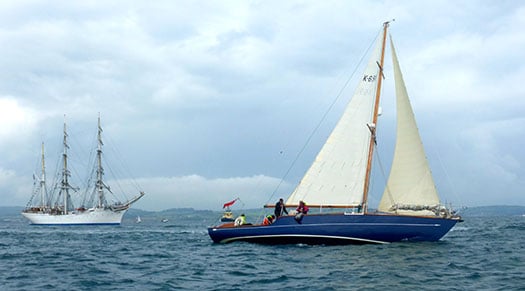
The real deal. Huff of Arklow with the Norwegian Tall Ship Statsraad Lehmkuhl on Belfast Lough last Sunday. Photo: W M Nixon
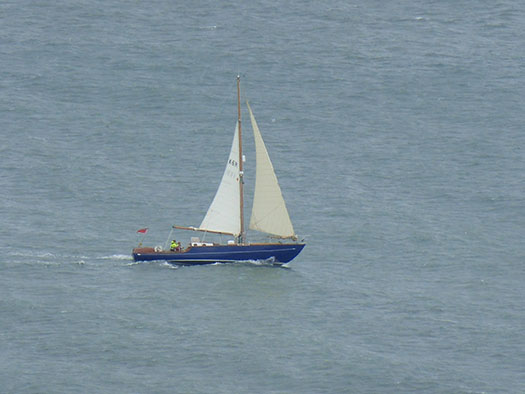
Doing what she does best. Huff of Arklow returns to Dublin Bay, as seen from the Baily at lunchtime Wednesday, after a record reaching passage from Ardglass Photo: W M Nixon
Describing her as authentic is the key to it. Since leaving Dublin Bay around 1970, Huff had undergone previous restorations, and had also survived an arson attack which miraculously left her hull intact but led to a further restoration which somehow lost the character of the boat even more.
But then in 2001 she started on the road back to a genuine restoration by being taken on by Uffa Fox enthusiast Andrew Thornhill of Bristol, who in turn saw to it that she was taken under the wing of a new classic yacht organization called Cremyll Keel Boats run by Dominic and Barbara Bridgman, and operating out of the old Mashford's boatyard at Cremyll on Plymouth Harbour.
They've re-created the flavour of Huff, they've re-captured her spirit, and in making their Dublin Bay debut at the Royal St George YC in the Volvo Dun Laoghaire Regatta 2015, they've paid their proper respects to the remarkable Douglas Heard.
In addition to being the founding President of the Irish Dinghy Racing Association in 1946, he was Commodore Royal St George YC 1960-1965, where his five innovative years in the top job were also his busy final five years with the Huff of Arklow, which he cruised and raced very extensively, with Iceland, the Azores and Portugal being visited by the distinctive dark blue boat from Ireland.
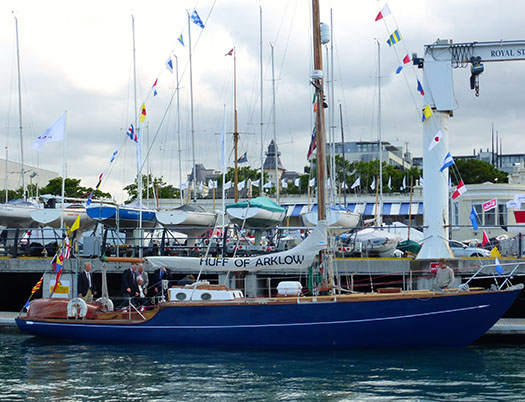 Home again – Huff of Arklow at the Royal St George YC, where she was the Commodore's yacht from 1960 to 1965. Photo: W M Nixon
Home again – Huff of Arklow at the Royal St George YC, where she was the Commodore's yacht from 1960 to 1965. Photo: W M Nixon
"Distinctive" is scarcely adequate. You'll never see anything like Huff. Basically, she's a double-size Flying Fifteen with a raised foredeck which comes well aft of amidships in order to provide impressive accommodation, and yet the low racing-style freeboard of a Flying Fifteen was retained down aft to give the new boat a very unusual appearance when she emerged from Tyrrell's yard in the spring of 1951.
But then they were used to "Mr Heard's new boat" being unusual down in Arklow, for in line with Uffa Fox's requirements, she was built with the hull upside-down in double diagonal planking. And among those who were there for Huff's welcome reception from Commodore Justin McKennna and the Royal St George members on Wednesday was Billy Murray of Arklow, who'd worked on the boat as a young trainee shipwright all those 64 years ago, and he remembered clearly that the lower freeboard aft was to help the owner get aboard the boat at moorings.
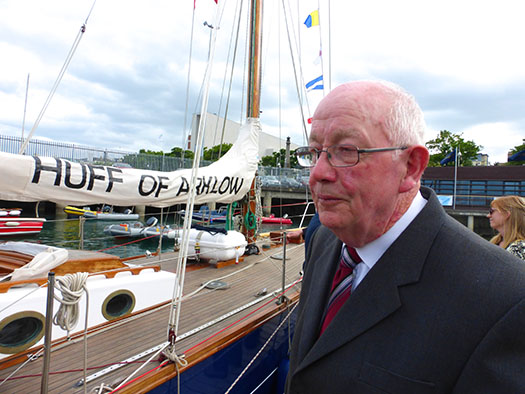
Billy Murray of Arklow, who worked on the building of Huff in the winter of 1950-51. Photo: W M Nixon
For Douglas Heard had been a wounded veteran (and a pensioner) of World War I since the age of 18, and was severely disabled in one leg. But he never let it impair his lifestyle, his zest in new things, his joy in sailing the sea, and his deep interest in boats. This was so total that he extended his seasons afloat with additional active involvement with the inland waterways.
As to how Huff performed, oddly enough she was better at cruising than racing, as she had this roomy accommodation which is very comfortable at sea, and with sheets eased she can go like a train – she arrived into Dun Laoghaire on Wednesday afternoon after a storming reach in a strong nor'wester from Ardglass in less than nine hours.
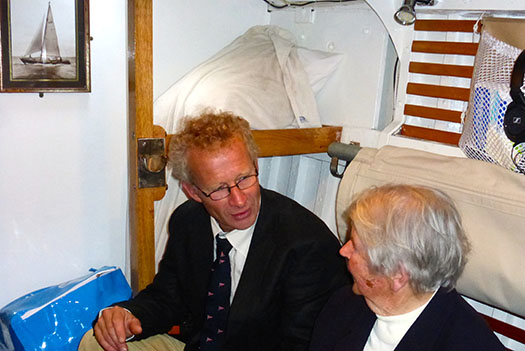
Aboard again. Ruth Heard, who sailed with her late husband Douglas on Huff of Arklow to the Azores, in the saloon with Dominic Bridgman Photo: W M Nixon
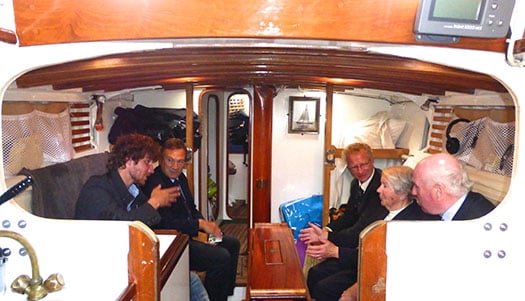
For a boat of her type, Huff of Arklow has remarkably roomy accommodation. Photo: W M Nixon
But for racing in Dublin Bay in her prime, her relatively small area of sail and her quite extensive wetted area meant that she could be sluggish in light airs, she was not at all happy to windward in a sea lumpier than the wind strength merited, and her lack of sharpness on a beat could leave her with a lot of work to do once sheets were eased.
So ideally what we would have needed on Thursday was a nice coastal course with lots of reaching. But of course, what we got was two rounds of a windward-leeward slugging match out on the middle of the bay, and the long old blue lady not at all enjoying tacking duels, and being embarrassed by having many smaller boats snapping around her heels.
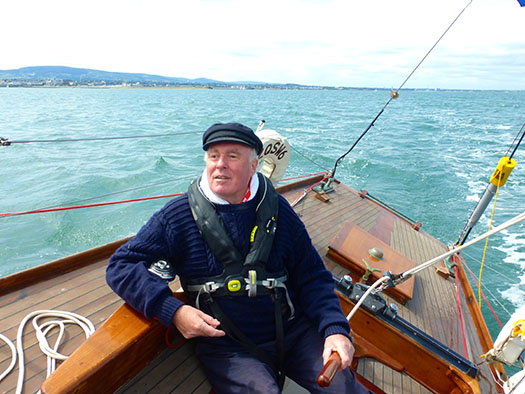
A dream comes true. Uffa Fox enthusiast Andrew Thornhill at the helm of Huff of Arklow, restored and returned to Dublin Bay after 45 years. Photo: W M Nixon
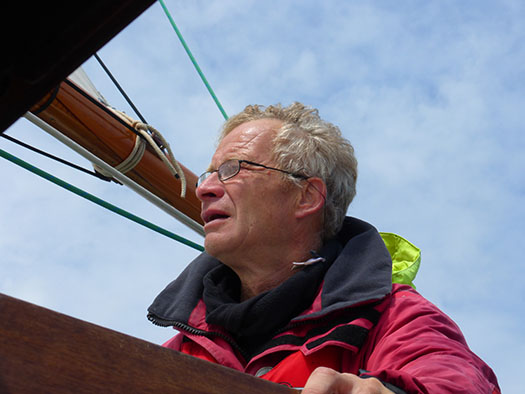 Will we clear them....? With Huff of Arklow charging along on port tack towards a gaggle of smaller more manoeuvrable boats on starboard, Dominic Bridgman has to make the call...... Photo: W M Nixon
Will we clear them....? With Huff of Arklow charging along on port tack towards a gaggle of smaller more manoeuvrable boats on starboard, Dominic Bridgman has to make the call...... Photo: W M Nixon
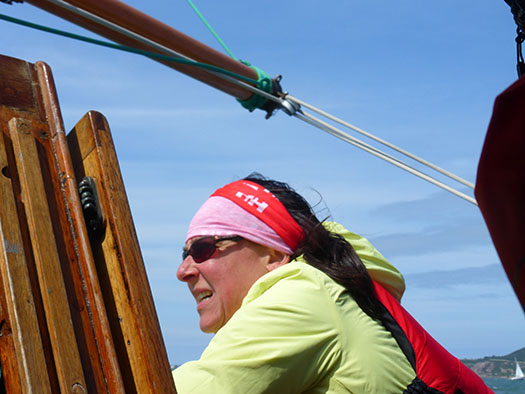 ......and he has his wife Barbara to help him get it right. Photo: W M Nixon
......and he has his wife Barbara to help him get it right. Photo: W M Nixon
Then things settled down a bit and we'd rather a good race with John Raughter's cheekily-named Fulmar 32 Chase Me from Bray SC. But this wasn't in the script at all. Chase Me wasn't even in our class. She was the next class down. However, despite there being 29 different classes in the Volvo Dun Laoghaire Regatta 2015, there wasn't a division for classics, as there doesn't seem to be a significant demand for this in Dublin Bay. And anyway, they'd need their own racing area exclusively for themselves, as many of them have highly individual handling characteristics.
So on a day when Quarter Tonners were dropping masts and our old girl with her veteran sails was at no stage being provided with her favourite point of sailing, we had to take our sport where were could find it. And if it was eventually with Cruiser Class 4 rather than our allocated Cruiser Class 3, so be it. Like the whaling skipper who went right round the world without so much as sighting a whale, let alone catching one, we had a helluva fine sail. And believe me, when Huff of Arklow came to the weather mark for the first time on this her first race in Dublin Bay in 45 years, there was pause for thought. But the old boat just tramped steadily on – she's seen it all before.
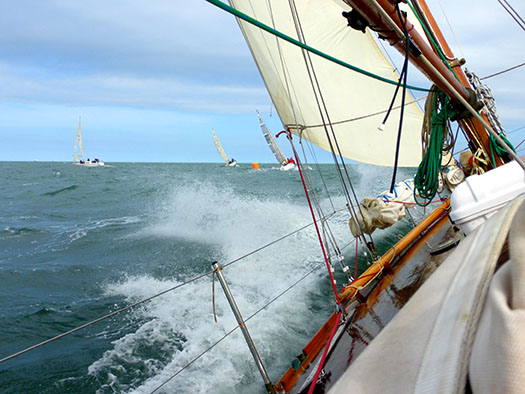 Quite a moment. Huff of Arklow comes to the weather mark in a Dublin Bay race for the first time in 45 years. Photo: W M Nixon
Quite a moment. Huff of Arklow comes to the weather mark in a Dublin Bay race for the first time in 45 years. Photo: W M Nixon
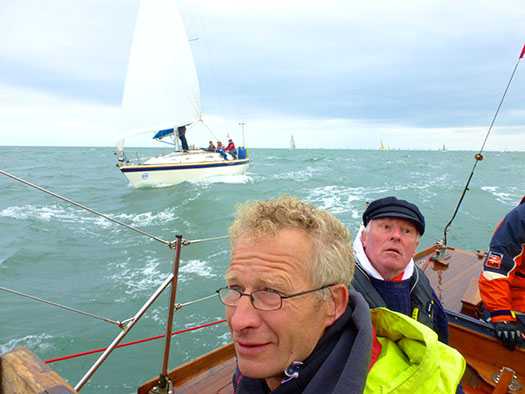 Not quite according to the script. We ended up having good sport with the Fulmar 32 Chase Me from Bray, even if she was in another class. Photo: W M Nixon
Not quite according to the script. We ended up having good sport with the Fulmar 32 Chase Me from Bray, even if she was in another class. Photo: W M Nixon
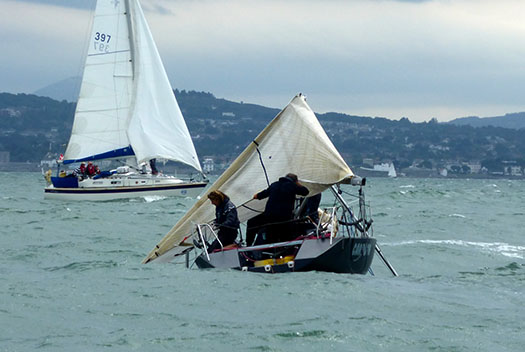 You win some, you lose some, you drop some....... On a day when Quarter Tonners were dumping their sticks, it was good to keep a 64-year-old boat in one piece and still racing. Photo: W M Nixon
You win some, you lose some, you drop some....... On a day when Quarter Tonners were dumping their sticks, it was good to keep a 64-year-old boat in one piece and still racing. Photo: W M Nixon
Thanks to our finish being out in the middle of the bay, your columnist had the opportunity to steer Huff hard on the wind back to Dun Laoghaire Harbour. With her long slim hull and separate skeg-hung rudder, you get the impression she wouldn't turn round out of control to look at you in the manner of modern high-volume boats. But she's remarkably sensitive to fine tuning to take the weight off the helm. In order to make the harbour mouth without tacking, I asked Dominic for an extra little grind on the jib sheet, and Huff immediately responded by showing a slight hint of lee helm. But a tiny bit of haul on the mainsheet, and she was back on virtually neutral helm, with just the essential though barely perceptible weather helm required for a thoroughbred.
With a bit of help from the first of the new ebb, we made it through the harbor mouth without tacking, which provided leisure to savour the scene. You never get tired of sailing into Dun Laoghaire Harbour, and when the Volvo Dun Laoghaire Regatta is in full swing at the end of a day's racing, it's like a continuously-changing living boat show with craft of every size and shape going hither and yon, while zooming through them the foiling Moths were having themselves a tremendous time on an in-harbour course.
We came into the Berth of Honour on the pontoons at the Royal St George, and the club's Rear Commodore Sailing, Frank O'Beirne, came down to see if all was well while our ship's company seemed to find themselves talking to just about everyone on the many boats coming in close past our berth, yet somehow they also got on with the sacred task of Milling the Prosecco. It didn't take too long to decide that Huff of Arklow had just won the Flying Thirty Worlds 2015.
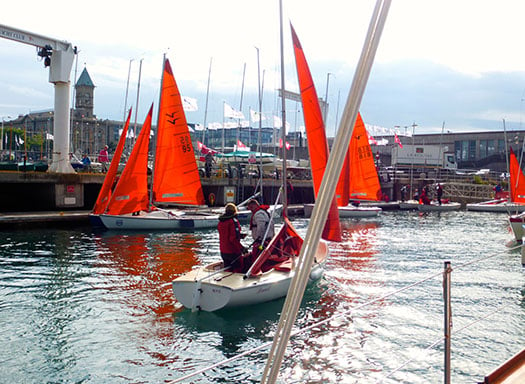
Banter time. By the time the Squbs were coming in after their race to glide close past Huff of Arklow in her Berth of Honour at the Royal St George, it had been discovered we'd just won the Flying Thirty Worlds 2015. Photo: W M Nixon
#dlregatta – George Sisk's Farr 42 'Wow' that was crowned ICRA Division Zero champion last month has won the opening coastal race of Volvo Dun Laoghaire Regatta this afternoon. The Royal Irish entry took the lead in the impressive 25 boat IRC offshore division in choppy seas and 20–knot winds. Second was the canting keel Cookson 50 Lee Overlay Partners skippered by Adrian Lee. Third was another east coast boat, the J122 Aquelina skippered by James Tyrrell of Arklow.
Among the fleets participating, Howth Yacht Club's Storm skippered by Pat Kelly took an early lead in the J109 National Championships being sailed as part of the 2015 regatta.
The Howth entry made the most of a strong sea breeze gusting to 20 knots that delivered championship conditions and got all 29 classes off to a prompt start on Dublin Bay.
3000 sailors are racing in the four day regatta, the biggest sailing event in Ireland this year. Last night no less than 17 protests were heard. There were a number of collisions and a number of rescues inlcuding one for a crew with a reported dislocated shoulder.
Second in the 11–boat J109 fleet was the National Yacht Club's Something Else skippered by John Hall with third place going to recently crowned Irish Cruiser (ICRA) Division One champion, Joker II (John Maybury).
Conditions could not have been more different than the first race this time two years ago when light winds frustrated sailors in the biennial event.
Pat Kelly's Storm has taken an early lead in the J109 National Championships and (below) neck and neck with Joker II with only yards to a hectic drop-gybe-round leeward mark


Wildwood, a 2014 Round Ireland Race competitor, sailed by Ian Patterson of East Antrim is racing in the 25-boat IRC coastal class
Today was equally as testing but for completely different reasons as sailors dealt with choppy seas and gusty conditions that led to a number of collisions and gear damage.
Racing is being staged until Sunday over five separate courses for a combined fleet of 415 boats, with over 180 visiting yachts from 69 yacht clubs.
An impressive line up of eight class zero boats has made Volvo Dun Laoghaire regatta one of the biggest turnout this year for the near 40–footers. What's even more impressive is the fleet has been drawn entirely from outside the Bay. First blood has gone to Conor Phelan's Ker 37 Jump Juice, just one of four entries from Cork Harbour. Second is returning Scottish entry from the Clyde, Roxstar, the XP38i, skippered by Jonathan Anderson. The 2013 winner of the overall Volvo trophy Nigel Biggs is back and sailing this year in class zero in a new C&C 30 design and placed sixth.

The new C&C30 designed by Mark Mills of Wicklow debuted in Class Zero - Afloat.ie's photo boat clocked her at 18–knots
Visitors also top class one's 18-boat fleet with the Beneteau First 36.7 Wildfire (DJ O'Malley) from Royal Northern Yacht Club leading from Fairlie Yacht club's MAT 1010 Now or Never. Third is local boat Boomerang, the Kirwan family's Beneteau 36.7, from the Royal St. George Yacht Club.

The Irish National Sailing School's Reflex 38 was going well in Division one until the jib halyard broke. Team INSS will be back in action on Friday as will these J109s below...


Yachts are sailing different courses including trapezoid, windward leeward, and triangular course configurations.
In the one design and dinghy divisions, sailing in the west or the north west of Dublin bay, there were plenty of familiar names at the top of the fleets.
Royal Ulster's Paul Prentice leads an impressive 16-boat Sigma 33 fleet, Ian Mathews the Flying Fifteens, Vincent Delany the Squibs and in an impressive 35–boat turnout for the GP14s, Ballyholme Yacht Club's Ruan O'Tiarnaigh and Niamh McCormick lead.
Unfortunately, a first race collision with a Beneteau 21 on the same course has almost certainly put Flying Fifteen contenders Ben Mulligan and Alan Green out of the regatta.
Sailing in Seapoint Bay, with a 150-160 degree wind, a seven boat Fireball dinghy fleet
sailed two races and Conor Clancy leads with a first and a third.
Racing continues tomorrow (Friday)
Biggs To Debut C&C30 at Dun Laoghaire Regatta
#dlregatta – Defending Volvo Dun Laoghaire Regatta (VDLR) 'Boat of the Week' Champion skipper Nigel Biggs returns to Dublin Bay next week for Ireland's biggest regatta. The Irish Times reports this morning on Biggs' new boat and an impressive debut at the Round the Island Race in Cowes last weekend.
UK–based Biggs hit a top speed of 18.3 knots downwind off the Isle of Wight, enough to put him 29th fastest monohull out of some 1800 competing on elapsed time in his new Mark Mills-designed American-built C & C 30 One Design. As Afloat reported previously, Biggs' new Checkmate XVI is the newest boat in the 415–boat Dun Laoghaire fleet. Read more in the Irish Times Sailing Column here.
New Cruise Berth Plans to be Lodged to An Bord Pleanala
#cruiseberth – Dun Laoghaire Harbour Company on behalf of the Dun Laoghaire Cruise Stakeholder Group will submit its planning application for a new cruise berth facility at Dun Laoghaire Harbour to An Bord Pleanála on Friday, 3rd July.
The planning application is being submitted as a strategic infrastructure project, and members of the public can review the planning application and associated environmental impact report – free of charge - from 9th July in the offices of An Board Pleanála on Marlborough Street, Dublin 1 or at the civic offices of Dun Laoghaire Rathdown County Council. In addition, a dedicated website, www.dlcruiseplan.ie, will contain all the relevant documentation. Once the documentation becomes available for public review, members of the public will also have an opportunity to submit their observations on the plans to An Bord Pleanála.
Plans for the new cruise berth facility have been developed so that Dun Laoghaire Harbour can accommodate next generation cruise ships. More on this here from W M Nixon.
The Dún Laoghaire Cruise Stakeholder Group is made up of Dún Laoghaire Harbour Company; Dún Laoghaire Rathdown County Council; and the Dún Laoghaire Bid Company. Ahead of finalising its plans, the Stakeholder Group carried out a pre-planning public consultation in April. Since then, the plans have been modified to reflect the consultation with harbour users, and the general public.
Speaking ahead of submitting the planning application, CEO of Dun Laoghaire Harbour Company, Gerry Dunne said: "The cruise industry is an important and growing sector of the tourism market. Cruise ships are getting bigger in size, offering more facilities to passengers, but requiring deeper water and longer berths to accommodate them. Over 50% of new ships currently on order are over 300m in length. At present Cobh is the only port in Ireland that can accommodate these vessels at any time. This means that Ireland, as a whole, is losing out on a growing and lucrative tourism market.
"At present, Dun Laoghaire must provide tendering services to large cruise ships in order to bring passengers to land. This is a cumbersome approach, and is a negative factor for many cruise operators. Indeed, in recent weeks, Dun Laoghaire has lost a number of cruise calls to Dublin Port; these large cruise ships can now reverse up the Liffey during high tide. In changing their berthing plans to Dublin Port, cruise operators have been very clear that their only reason for the change rests with the convenience of bringing passengers right on to a berth, both from a safety and efficiency point of view.
"The plans for a suitable berthing facility will put Dun Laoghaire in a prime position to attract cruise business. As a harbour, Dun Laoghaire has been mandated by the Government to exploit its potential as a marine leisure facility, and winning and developing cruise business is a central part of our work in this regard," added Mr Dunne.
Under the plans submitted to An Bord Pleanála, the following will be among the features that will be considered:
· A 435 metre pier, with an underpass to cater for the passage of club launches.
· Dredging of an access channel from outside the Harbour to St Michael's Pier, including a 500m diameter turning circle outside the Harbour mouth.
· A shared-use public and pedestrian zone adjacent to the existing Marina and connecting to the Marina Eastern Breakwater.
· A new high-quality footpath along Harbour Road.
· Ancillary site and landscape works.
Dun Laoghaire Regatta 2015 Sailing Instructions Online Here!
#RNLI - Ireland's second busiest coastal lifeboat station is still without a pontoon for the safe boarding and alighting of crew and casualties, as the Sunday Independent reports.
Dun Laoghaire RNLI still uses a motor tender to transfer between the lifeboat station next to the National Yacht Club and its all-weather lifeboat anchored in the harbour.
This has proved to be a safety issue in the past, with one crew member breaking an arm while boarding the lifeboat in rough weather four years ago.
Lifeboat volunteers are also forced to use the NYC's pontoon when bringing casualties ashore, which can be problematic when its berths are full such as in the summer season.
The newspaper highlights the projected €200,000 cost of funding a dedicated launch pontoon for the lifeboat station compared to the multimillion investments around it as part of the Dun Laoghaire Harbour Masterplan, including an urban beach and a proposed new cruise liner berth.
The Sunday Independent has more on the story HERE.





























